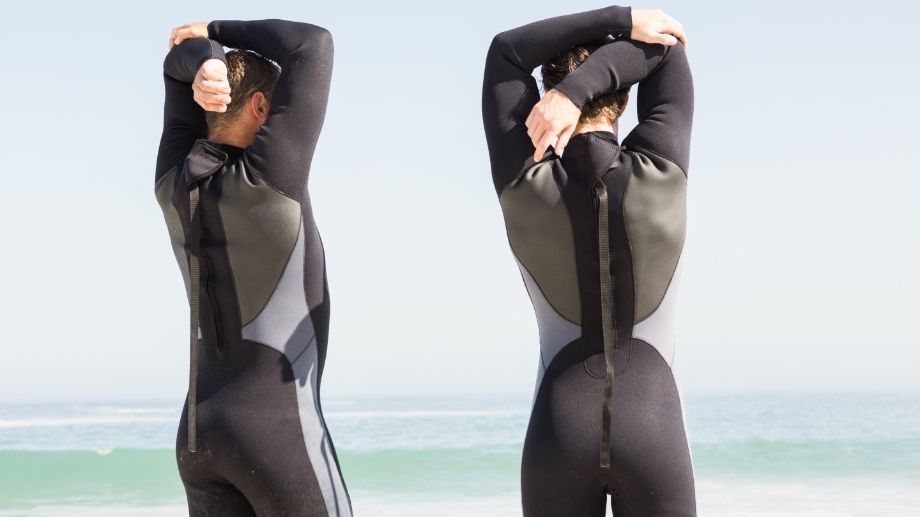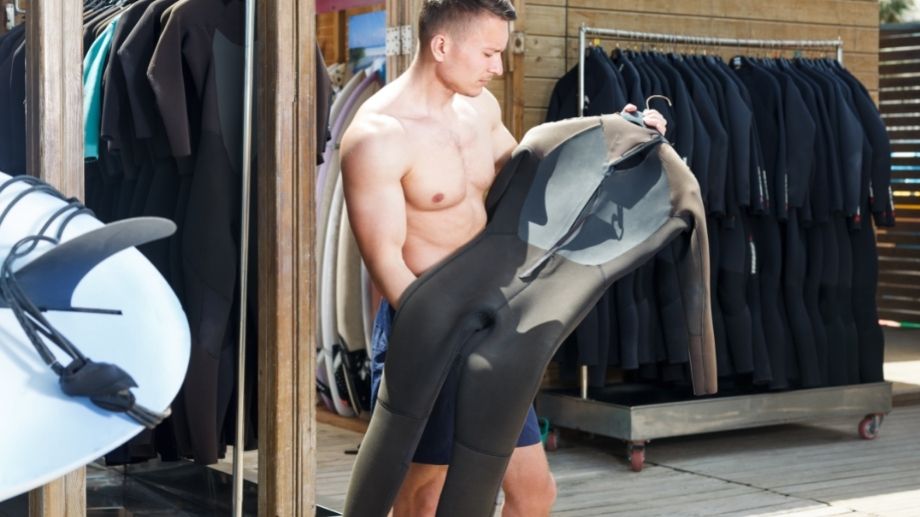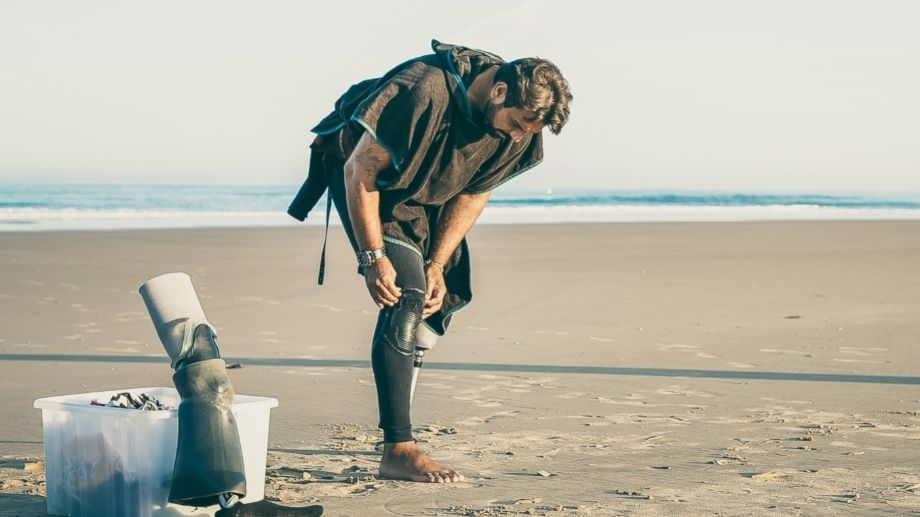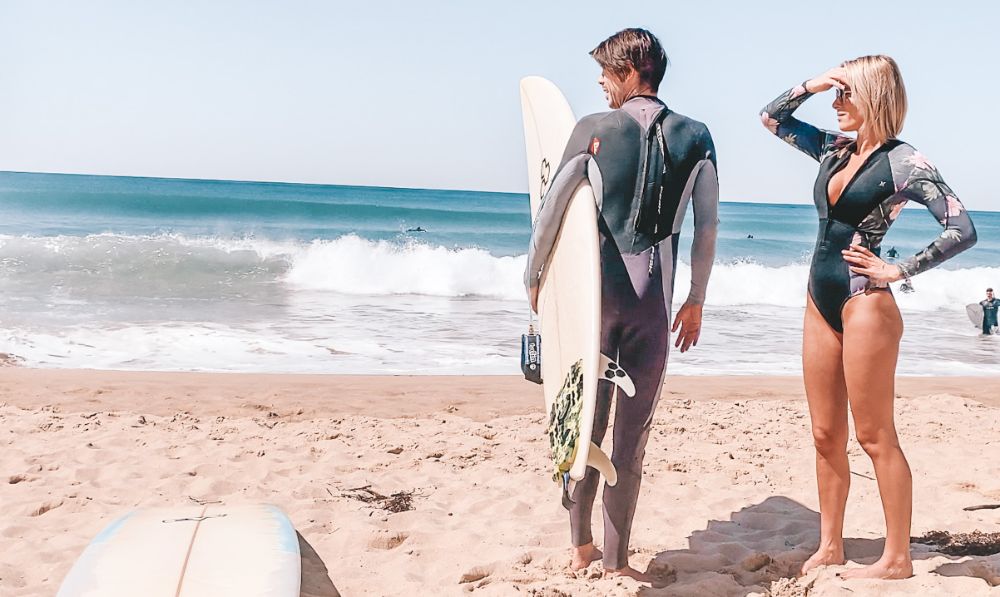Buying a new wetsuit doesn’t have to be an adventure (save that for the surf).
If you know what you’re looking for, finding the perfect fitting wetsuit is actually pretty easy.
One of the biggest hang ups is figuring out exactly how tight a wetsuit should be. For surfing, it can be particularly tough because uninhibited movement is so important both for paddling and for actually riding the waves.
You want your wetsuit to be tight, but not too tight. So how tight does a wetsuit really need to be for surfing?
For surfing, a wetsuit should be tight enough that there is no loose fabric but not so tight that it digs into your skin around your wrist, ankles and neck or pulls up too tight on your crotch. It should fit tight against your skin but you should have full range of movement in your arms.
If you're struggling to lift up your arms over your head, if it feels painfully tight on your crotch or if it is cutting off circulation or causing large skin indentations around the ankles, wrist and neck then these are all signs that your wetsuit is too tight and you need to choose a different size.
I’ve bought many wetsuits over the years and have made just about every sizing mistake you can think of. From oversized wetsuit that let in water and caused chafing to undersized wetsuits that nearly choked me.
In this article, I’ll help you learn from my mistakes by teaching you why a wetsuit needs to be tight, how tight a wetsuit should be for surfing, and how to tell if your wetsuit is too tight.
How Tight Should A Wetsuit Be For Surfing?
One of the most important parts of a wetsuit is how it fits — and that’s particularly true for surfing, where having an unrestricted range of motion can be the difference between bailing and a perfect 10 (talking waves here not women…but there is this article on looking good in a wetsuit).
But finding the right balance between tight enough to keep you warm and loose enough to allow free movement can be tricky.
Luckily, a few simple tips can get you into the perfect wetsuit and on your board in no time.
Check For Loose Fabric
A wetsuit should fit flush against your body, almost like a second skin — but it shouldn’t be stretched or pulled when you’re standing still either.
Check the armpits, crotch, and lower back for loose fabric or bunching. Women, in particular, should check the fit at the chest.
I remember when my daughter tried on her mom's wetsuit. The length was ok but the bust was HUGE for her and looked ridiculous.
Give the neoprene a little tug — it should snap back into place without leaving a noticeable pocket of air (just be careful snapping anything around the crotch).
Arch your back. If it buckles and bunches, it’s too loose. If it stretches and pulls away from your back, it’s too tight.
There will likely be some minor folds around the armpits when your arms are down but if you notice large pockets of air in this area it could be a sign the wetsuit is too big.
Test Your Range Of Motion

A full range of motion is important for surfing, especially in the shoulders. After all, you use your arms for paddling, popping up, and keeping your balance.
The best way to test is to toss the wetsuit on and move around.
Extend your arms over your head. If the wetsuit pulls at your shoulders and stops the movement short, it’s too small.
This is one of the best ways to tell if a wetsuit is the right fit for you. If you're struggling to get your arms over your head and feel restricted while doing a paddling motion the wetsuit is likely too small and it's going to hold you back in the water and make paddling more difficult.
Cross your arms in front of you. You’ll feel a pull at the back of the wetsuit, but it should still allow the full movement.
Add in some dynamic movements to see how the wetsuit responds — try a few squats, mimic paddling, throw in some knee thrusts.
While your movements will feel slightly restricted due to the tight material, they shouldn’t actually be limited in any way.
The Type Of Wetsuit Makes A Difference
Depending on the type of wetsuit, you may have a couple other considerations to make.
If the wetsuit has sleeves or legs that are too long for you, they’ll bunch at the wrists or ankles and allow too much water into the suit. Sleeves and legs should end just before the wrist bone and ankle bone respectively.
You also don't want the wetsuit to be too short. If the sleeves and legs make you look like a kid who's had a growth spurt and their mom hasn't bought them any new clothes then you might want to move up a size.
Different brands have different sizing, so just because an S or M in one brand doesn't fit you doesn't mean that same size in another brand won't.
Longer sleeves will naturally restrict movement in the arms more than short-sleeved or sleeveless wetsuits. This is normal, you just don't want it to feel too tight and restricted.
Thicker wetsuits, like those in the 5mm range, are going to feel tighter — even if they’re actually the right fit and semi-dry or dry suits are intentionally right around the ankles, wrists and neck to not allow any water in at all.
Wetsuits Will Feel Slightly Tighter In The Store

Lastly, keep in mind that the tightest your wetsuit will ever feel is when it’s new in the store.
Wetsuits always feel tighter when they’re dry. Getting a layer of water between you and the neoprene will help it feel looser and more natural.
Brand new wetsuits often feel a little tighter as well.
While modern materials mean that wetsuits no longer need to be broken in in the traditional sense, they’re still at their tightest when unworn and will stretch slightly in the water and with regular use.
If you’re torn between two sizes, one that feels just a bit too loose and one that feels just a bit too tight, the slightly tight suit will probably fit better in the long term. However, it's still probably a good idea to try different brands to find one that feels just right.
Why Does A Wetsuit Need To Be Tight?
The purpose of a wetsuit is to keep you warm in cold water.
A wetsuit works by trapping a thin layer of water between your skin and the wetsuit. This layer of trapped water is quickly warmed by your body heat and the wetsuit insulates you from the cold water or air outside the suit.
It's a common misconception that the layer of water is keeping you warm…it isn't. The more water the colder you will become and this is why a wetsuit needs to be tight fitting – to stop excess water entering your suit.
If a wetsuit is too loose, it allows too much water between you and the suit and your body heat is unable to keep the water warm.
It will also cause something known as “flushing”. This is when you duck dive under a wave or have a wipeout and fresh cold water flows through your suit pushing out the warm water your body has heated up.
How Do You Know If A Wetsuit Is Too Tight?

A wetsuit that’s too tight can be an even bigger problem than one that’s too loose. A large wetsuit might lead to you being colder or maybe some chafing but a wetsuit that's too small will restrict movement, cause rashes and can even be painful once you get into the water.
Generally, if the wetsuit feels uncomfortable to wear, it’s too small for you. Remember, it's very difficult to stretch modern wetsuits and they aren't designed to need breaking it. While it'll expand slightly, the wetsuit should fit you in the store.
While a wetsuit may feel a little awkward at first, especially if you’re not used to wearing one, it shouldn’t be outright uncomfortable.
Unnatural, strained breathing and feelings of claustrophobia mean that it’s definitely time to size up.
If you can’t comfortably slide a finger or two under the neckline, wrists, and ankles it’s probably too small for you.
And lastly, keep in mind that wetsuits are typically pretty challenging to get into, but if it feels almost impossible there’s a good chance that it’s just too small.
The exception to this is thick 5-7mm suits or semi-dry or dry suits which need to be EXTRA tight to keep you warm in frigid weather. For these wetsuits you may need a wetsuit lubricant which helps you get into your wetsuit easier…or sometimes a plastic bag over your feet and hands can work too.
Final Thoughts
Finding the right fit for a wetsuit can feel like an uphill battle if you don't know what to look for. A wetsuit that’s too loose won’t effectively keep you warm and one that’s too tight will be uncomfortable and restrict movement.
To know if your wetsuit is the right size for surfing, check for the following.
- Loose fabric or pockets of air mean your wetsuit is too loose.
- If your wetsuit cuts off circulation or makes breathing feel less natural, it’s too tight.
- Range of motion may feel slightly restricted, but no movement should actually be limited.
- New, dry, and thick wetsuits will always feel tighter, even if they’re the right size.




